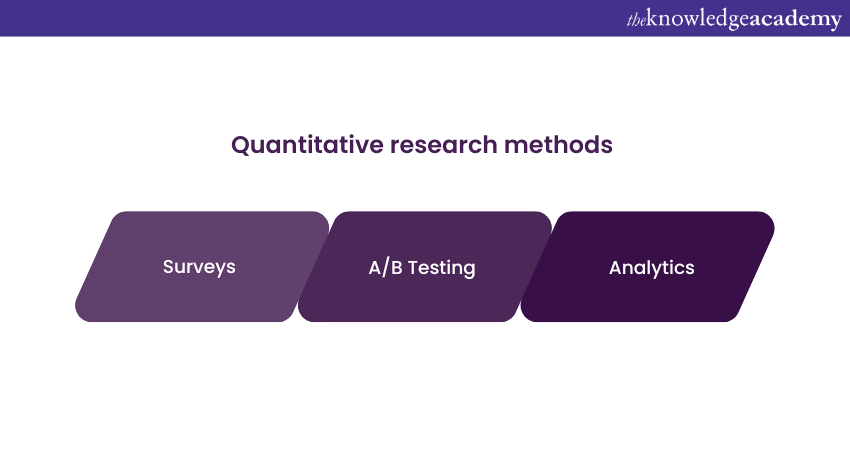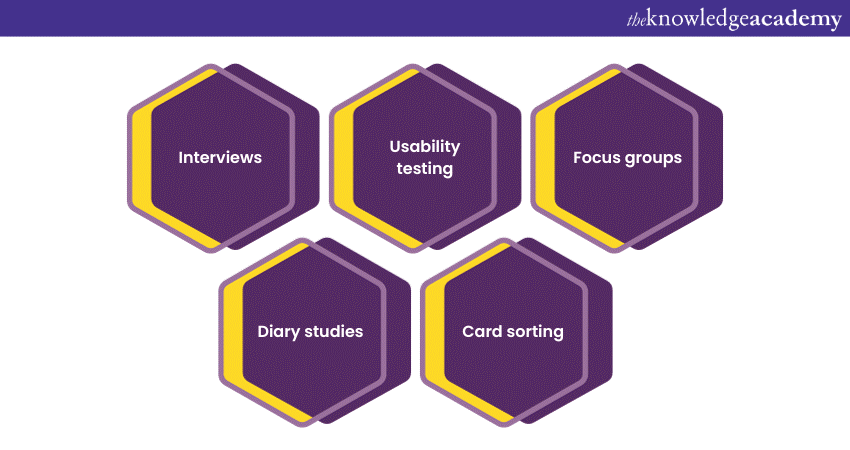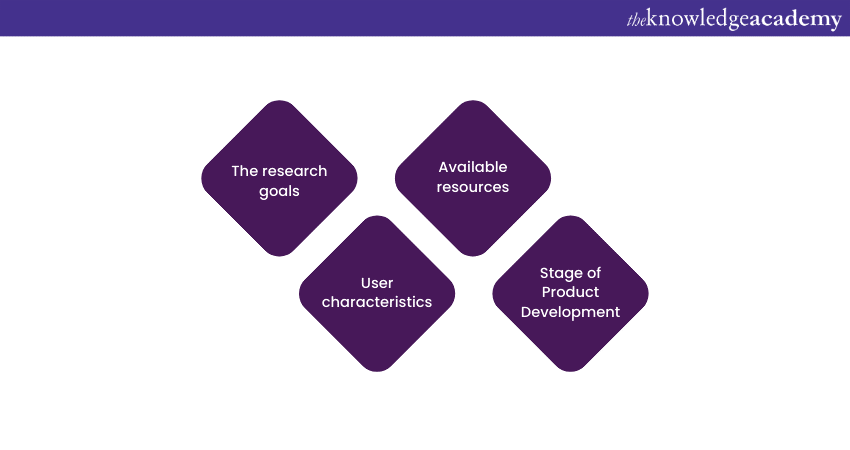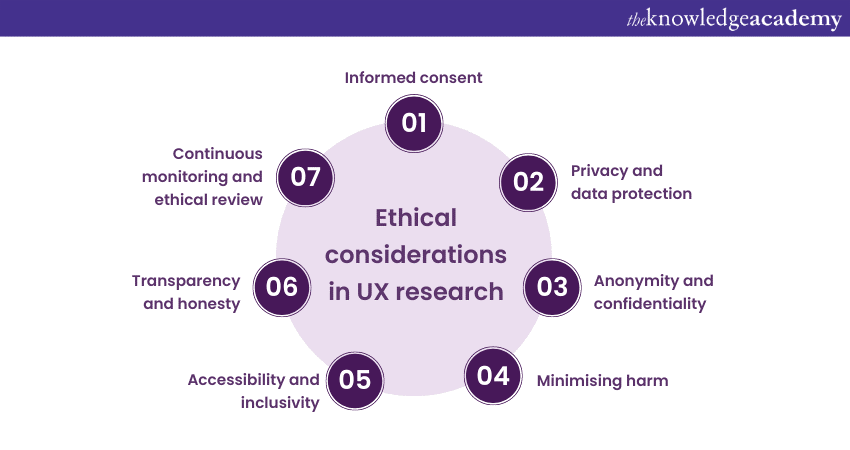We may not have the course you’re looking for. If you enquire or give us a call on 01344203999 and speak to our training experts, we may still be able to help with your training requirements.

close
Press esc to close

close


Press esc to close

close
Fill out your contact details below and our training experts will be in touch.



Back to Course Information
We ensure quality, budget-alignment, and timely delivery by our expert instructors.

User Experience (UX) Research plays a crucial role in developing products and services that fulfil the needs and expectations of users. It helps designers and developers gain insights into user behaviour, preferences, and pain points, ultimately leading to more user-friendly and effective solutions. In this blog, we will explore various UX Research Methods that can be employed to better understand users and their interactions with digital products.
Table of Contents
1) What is UX Research?
2) Types of UX Research Methods
3) Choosing the right research method
4) Combining quantitative and qualitative research
5) Ethical Considerations in UX Research
6) Continuous UX Research
7) Conclusion
User Experience (UX) Research is the systematic study of how users interact with digital products and services. It seeks to understand user behaviours, preferences, and motivations to inform design decisions. By employing UX Research Methods like usability testing and surveys, UX Research ensures that products are user-friendly, effective, and aligned with user needs.
This section of the blog will expand on the two broad types of UX Research Methods.
Quantitative research revolves around numbers, metrics, and statistical analysis. Its primary aim is to answer questions related to the "what" and "how much" aspects of user behaviour. Let's take an in-depth look at some key quantitative UX Research Methods:

Surveys are great instruments for data collection, enabling researchers to gain a broad understanding of user preferences, opinions, and satisfaction levels. They can be executed through various channels, both online and offline, based on the target audience and research objectives.
a) Online surveys: Online surveys have gained immense popularity due to their cost-effectiveness and the ability to reach a vast and diverse audience swiftly. Platforms such as Google Forms, SurveyMonkey, and Typeform make it simple to create and distribute online surveys. This method is highly suitable for gathering feedback on website experiences, mobile applications, or digital services.
b) In-person surveys: In certain context, in-person surveys remain relevant, particularly when it comes to collecting data from specific demographics or in physical settings such as retail stores or public events. While the process may be more time-consuming, it can yield invaluable insights.
Surveys are instrumental in understanding user preferences, gauging satisfaction levels, and identifying pain points, often employing Likert scales to measure attitudes and sentiments quantitatively.
A/B testing, also called split testing, is the gold standard for discerning which design or feature variation performs better in terms of user engagement and conversion rates. It's a powerful method for making data-driven design decisions and optimising user experiences.
A/B testing involves presenting two or more versions of a design element or feature (usually labelled as A and B) to different user groups simultaneously. The aim is to determine which version elicits a more favourable response from users based on predefined success metrics.
The success of A/B testing hinges on meticulous planning. It's essential to define clear objectives, select appropriate success metrics (e.g., click-through rates, conversion rates, bounce rates), and employ specialised A/B testing tools and platforms like Google Optimise or Optimisely. A/B testing is invaluable for refining user interfaces, maximising conversion rates, and ultimately enhancing the user experience through evidence-based decision-making.
Analytics tools are the unsung heroes of the digital world, quietly and comprehensively tracking user interactions and behaviour within websites and applications.
a) Web analytics: For websites, tools such as Google Analytics offer a wealth of data, including user journeys, page views, bounce rates, and conversion funnels. This quantitative data is crucial for understanding how users navigate and engage with your web content.
b) App analytics: In the mobile app domain, platforms like Firebase Analytics provide insights into user engagement, retention rates, in-app events, and even crash reports. This data is essential for optimising mobile app experiences.
Quantitative data from analytics tools facilitates the identification of trends, monitoring of user behaviour over time, and the assessment of the performance of specific features or content. It serves as the foundation for data-driven decision-making, enabling designers and developers to fine-tune their digital products for enhanced user satisfaction.
Gaining a comprehensive understanding of qualitative research methods is similar to becoming a skilled artist, expert at sculpting user-centric experiences. Qualitative UX Research delves into the details of the "why" and "how" behind user behaviour, aiming to understand the motivations, emotions, and experiences that quantitative data alone cannot shed light on. Below, we delve deeper into several key qualitative UX Research Methods and explore their advantages.

There are two broad categories of interviews, namely:
1) One-on-one interviews: These in-depth conversations provide a personal and confidential space for users to share their thoughts, feelings, and opinions openly. One-on-one interviews excel at facilitating a deep exploration of user experiences and preferences.
2) Contextual interviews: Conducted within the user's natural environment, contextual interviews offer a glimpse into how users interact with a product in real-world scenarios. This method often reveals unique insights that might not emerge in controlled environment.
Interviews offer the advantage of fostering trust and rapport between the researcher and the participant. This trust often leads to participants sharing deeper insights and more honest feedback. Additionally, these interviews allow for real-time clarification of responses and follow-up questions, ensuring a comprehensive understanding of the user's perspective.
Usability testing refers to observing users as they interact with a product, be it a prototype or a fully developed application. This method evaluates the ease of use and overall user experience by closely monitoring user actions, interactions, and difficulties.
Successful usability testing necessitates meticulous planning, including the creation of realistic test scenarios and the selection of representative user participants. This ensures that the test conditions mimic real-world usage as closely as possible. Usability testing generates valuable feedback and metrics like task completion rates and time on task. These metrics are crucial for identifying areas in need of improvement and validating design decisions.
Usability testing provides a direct and authentic view of how users engage with a product. It uncovers specific pain points, usability issues, and areas of confusion, enabling designers to make informed improvements. Additionally, usability testing validates design decisions by placing them in the context of real user interactions.
Focus groups are a small group of participants who discuss their experiences, opinions, and preferences related to a product or service. This method leverages group dynamics and encourages the exchange of ideas. Focus groups are very valuable for exploring user perceptions, uncovering potential pain points, and generating ideas for product enhancements. They are particularly useful for gathering diverse opinions and capturing group consensus.
Effective facilitation is essential for guiding discussions, encouraging participation, and extracting meaningful insights from focus group sessions. Skilled facilitators keep the conversation on track and make sure that all participants have an opportunity to share their thoughts.
Focus groups excel at capturing diverse opinions and generating a range of ideas within a dynamic and interactive environment. They provide insights into how users perceive a product within a social context, allowing researchers to gauge the influence of group dynamics on user perspectives. Moreover, they are cost-effective for gathering feedback from multiple participants simultaneously.
Diary studies involve participants maintaining a journal or diary of their experiences with a product over a specified period. Participants record their thoughts, actions, and emotions, providing a longitudinal view of their interactions. Participants typically record their experiences daily or at specified intervals, making note of their interactions, challenges, and any notable observations related to the product.
Diary studies offer a longitudinal perspective on user experiences, allowing researchers to track changes and patterns over time. They capture real-time, unfiltered insights into user behaviour and emotions, providing a holistic understanding of how users engage with a product throughout their journey. Participants have the flexibility to provide feedback in their own words and at their own pace, fostering authenticity in their observations.
Card sorting is a method often used to understand how users organise and categorise information or content within a digital product, such as a website or app. It aids in creating more intuitive information architectures. Participants are given a set of cards, with each representing a piece of content or information. They are then asked to group the cards into categories that make sense to them.
Card sorting unveils how users naturally think about content categorisation, aligning the product's structure with users' mental models. By involving users in the process of information organisation, it fosters a sense of ownership and user-centric design. Additionally, card sorting can uncover unexpected insights about user preferences, leading to more effective navigation structures.
Unlock your creative potential and master UX/UI Design with our comprehensive UX / UI Design Jumpstart Training – join now and jumpstart your career!
The process of selecting the most suitable UX Research method similar to picking the perfect tool from a well-equipped toolbox. Each of the UX Research Methods has its own strengths and limitations, and the decision you make can hugely impact the success of your research efforts and, by extension, the effectiveness of your product or service. To make an informed choice, you should consider several critical factors:

Understanding your research objectives is the essential first step in determining the right research method. What specific insights are you seeking? Are you aiming to measure the performance of an existing product, explore user preferences for a new feature, or gain a deep understanding of the user journey through your website or application? Your research goals should guide your choice between quantitative and qualitative methods, or even deploying a combination of both.
Clearly defined research objectives serve as a roadmap for your entire research process. They help you stay focused on what you want to achieve and allow you to establish criteria for success, making it easier to evaluate the effectiveness of your chosen research method.
Resources, including time, budget, and personnel, are often finite and must be considered when selecting a research method. Some methods require more significant investments in terms of time and finances, while others can be conducted with relatively minimal resources.
Realistically assessing available resources enables you to make practical decisions. If you're working with tight budgets and timelines, you may lean towards methods that are efficient and cost-effective. Conversely, if resources are abundant, you have the freedom to consider more comprehensive and elaborate research tools.
The characteristics of your target audience are fundamental in tailoring your research method to ensure that it captures insights relevant to that specific user group. Demographics, such as age, location, technological proficiency, and cultural background, can significantly influence the choice of method.
Customising your research method to align with the characteristics of your intended users ensures that you collect insights that are representative of your target audience. For example, if your product primarily targets elderly users, conducting usability testing with this demographic may be more insightful than relying solely on surveys or A/B testing.
The stage of your product's development also plays a pivotal role in dictating the most appropriate research method. Different stages require different types of research. In the early ideation and concept testing phase, you might be more focused on understanding high-level user needs. Conversely, in the later stages, your focus could shift towards evaluating the usability of a fully developed product.
Matching the research method to the product's development stage ensures that you address the most critical questions and challenges at each phase. Early-stage research helps in refining concepts and ensuring alignment with user needs, while later-stage research is essential for validating design decisions, uncovering usability issues, and ensuring the creation of a user-friendly end product. By taking these factors into account, you can tailor your research approach to the unique requirements of your project. For instance:
1) If you're in the early ideation phase and your goal is to understand user needs broadly, conducting one-on-one interviews or surveys may be the most suitable method.
2) If you have a fully developed product and you're seeking to uncover usability issues and improve user experience, usability testing with representative users can provide invaluable insights.
3) When you want to compare the performance of two design variations, A/B testing is a quantitative method that allows you to make data-driven decisions.
4) If you're looking to gather diverse perspectives and stimulate discussion to refine product features, focus groups can be highly beneficial.
Unlock the secrets of exceptional User Experiences - sign up for our User Experience (UX) Masterclass Course now!
A nuanced and comprehensive understanding often emerges when you blend quantitative research with qualitative research. While these two approaches are distinct, they are not mutually exclusive, and combining them can yield a richer, more holistic view of user behaviour and preferences. Let's delve into the concept of combining quantitative and qualitative UX Research Methods, exploring its benefits and considerations.
Mixed-methods research is an approach that integrates both quantitative and qualitative research methods within a single study or research project. It seeks to harness the strengths of each method to compensate for their respective limitations. In essence, it's about triangulating data from multiple angles to obtain a more comprehensive understanding. The following are some of the advantages of mixed-methods research:
a) Comprehensive insights: By employing both quantitative and qualitative methods, you can capture a wide range of data, from numerical metrics to in-depth narratives. This comprehensive dataset provides a more profound insight into user behaviour and motivations.
b) Validation: The findings from one method can often validate or shed light on the findings of the other. For instance, if a usability test reveals a usability issue, quantitative data from A/B testing can confirm its impact on a larger scale.
c) Contextual understanding: Qualitative research helps to contextualise quantitative data. It allows you to understand not just what users are doing but also why they are doing it. This context is crucial for making informed design decisions.
d) Iterative design: By continuously gathering both types of data, you can adopt an iterative approach to design. You make data-driven improvements based on quantitative insights and fine-tune the user experience using qualitative feedback.
The following are the benefits of combining methods of research.
1) Richer user profiles: Quantitative data can provide broad demographic and behavioural insights about your user base. However, qualitative research allows you to create richer user profiles by delving into their motivations, needs, and pain points. This depth is important for crafting user-centric solutions.
2) Identifying usability issues: Quantitative data from A/B testing or surveys can highlight usability issues, such as high bounce rates or low conversion rates. Qualitative research, like usability testing or interviews, helps you detect the root causes of these issues and provides actionable insights for improvement.
3) Evaluating the user experience: Combining methods is particularly effective for evaluating the overall user experience. For example, while analytics can show where users drop off, usability testing can reveal why they abandon a task. This combined knowledge is essential for enhancing the overall UX.
While combining quantitative and qualitative research is undeniably beneficial, it does come with some challenges and considerations:
1) Resource intensity: Careful planning and allocation of resources is crucial as conducting both types of research can be resource-intensive, requiring time, budget, and personnel.
2) Data integration: Managing and integrating data from different sources can be complex. Researchers must have the skills and tools necessary to combine and analyse both types of data effectively.
3) Sequential vs concurrent: You can either conduct quantitative and qualitative research sequentially or concurrently. The choice depends on your project's needs and constraints.
4) Balancing act: Achieving the right balance between the two approaches is crucial. Over-reliance on one type of data can limit the benefits of combining methods.
Unlock your creative potential in website design – sign up now and transform your skills with our Website Design Course!
Ethical considerations lie at the very heart of User Experience (UX) Research, playing a crucial role in ensuring that the pursuit of knowledge and improvement is conducted responsibly and with the utmost respect for the rights, privacy, and well-being of research participants. In this discussion, we will delve into some of the key ethical considerations that should guide UX Research practices and explore the advantages of adhering to these principles.

At the core of ethical UX Research is the principle of informed consent. It entails obtaining the willing and informed agreement of participants before involving them in any research activities. This consent process should provide participants with comprehensive information about the research's objectives, procedures, potential risks, and benefits. Importantly, it gives them the liberty to ask questions and make an autonomous decision regarding their participation.
Ethical UX Research requires meticulous privacy and data protection practices, particularly when dealing with sensitive user data. Researchers are obliged to handle participants' personal information with the utmost care, adhering to relevant data protection regulations such as GDPR in Europe.
Guaranteeing the anonymity and confidentiality of participants is crucial in ethical UX Research. This involves taking measures to protect participants' identities and ensuring that their responses cannot be traced back to them.
Ethical UX Research extends to the responsibility of minimising harm to participants throughout the research process. Researchers should identify potential risks, such as emotional distress or discomfort, and take proactive measures to mitigate them. They should also be prepared to offer appropriate support if participants encounter adverse effects.
Ethical considerations in UX Research entail conducting studies that are accessible and inclusive to a diverse range of participants, including those with disabilities or from underrepresented groups. Researchers should take steps to accommodate participants' needs and ensure that the research process is equitable.
Maintaining transparency and honesty in interactions with participants is a cornerstone of ethical UX Research. This involves accurately representing the purpose of the research, providing clear instructions, and reporting the findings truthfully, even if they are unfavourable or unexpected.
Ethical considerations in UX Research should not conclude with obtaining consent; they should be an ongoing commitment. Researchers should continuously monitor ethical considerations throughout the research process. This vigilance involves identifying ethical dilemmas as they arise and addressing them promptly. Additionally, conducting ethical reviews or seeking input from ethics committees or review boards can provide valuable guidance and oversight.
.png)
Continuous research in UX Design is an approach that emphasises the need for regular and ongoing data collection, analysis, and refinement throughout the product development lifecycle. Rather than conducting research as a one-off event, it recognises that user needs, preferences, and behaviours can change over time.
Therefore, it advocates for a continuous feedback loop that informs design decisions, validates assumptions, and identifies areas for improvement. To implement continuous research effectively, several key components must be integrated into the UX Design process:
Establishing user feedback loops is central to continuous research. This involves collecting feedback from users at various touchpoints, such as through surveys, feedback forms, or customer support interactions. User feedback provides valuable insights into user satisfaction, pain points, and areas for improvement.
Regular usability testing sessions are a cornerstone of continuous research. By observing how users interact with a product and identifying usability issues, design teams can make incremental improvements to the user interface and overall user experience.
A/B testing is a method for comparing two or more variations of a design element or feature to determine which performs better with users. This iterative approach allows designers to make data-driven decisions about which design changes are more effective.
Leveraging analytics and user data is crucial for tracking user behaviour over time. It provides insights into user journeys, usage patterns, and trends that can inform design decisions. Continuous analysis of this data helps detect areas that may require attention.
Conducting user research and interviews on an ongoing basis allows designers to gain deeper insights into user needs and motivations. Regular interactions with users provide qualitative data that complements quantitative metrics.
Unlock the world of Android app development and shape the future of mobile technology with our comprehensive Android App Development Training!
In the world of UX Design, knowledge of diverse UX Research Methods is essential. Each method offers a unique lens to understand user behaviour and preferences. From interviews that establishes trust to usability testing that validates design decisions, these tools empower designers to craft more user-centric experiences. By embracing a rich toolkit of research methods, designers can uncover profound insights and ensure their digital products resonate with users' needs and preferences.
Unlock your potential in App and Web Development with our expert App and Web Development Training Courses - sign up today!
Date
 User Experience (UX) Masterclass
User Experience (UX) Masterclass
Thu 28th Dec 2023
Thu 11th Jan 2024
Thu 6th Jun 2024
Thu 26th Sep 2024
Thu 26th Dec 2024